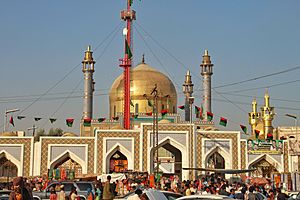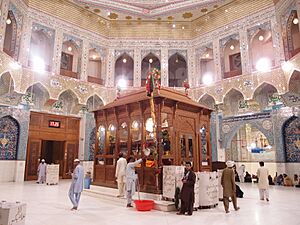Lal Shahbaz Qalandar facts for kids
Quick facts for kids Sayyid Usman Marwandi |
|
|---|---|

Tomb of Lal Shahbaz Qalandar in Sehwan
|
|
| Religion | Islam |
| Other names | Lal Shahbaz Qalandar |
| Personal | |
| Born | Usman 1177 Marwand |
| Died | 19 February 1274 (aged 96–97) Sehwan (present-day Sindh, Pakistan) |
| Parents | Sayyid Kabiruddin (father) |
| Senior posting | |
| Based in | Sehwan |
| Title | Qalandar |
| Period in office | 12th/13th century |
Hazrat Sayyid Usman Marwandi (born 1177, died 19 February 1274) was a very famous Sufi saint and poet. He is better known as Lal Shahbaz Qalandar. He lived in what is now Pakistan and Afghanistan.
Lal Shahbaz Qalandar was born in Marwand, a place in Sistan. His family came from Baghdad. He later moved to Sindh and settled there. He helped many people learn about Islam. The local Sindhi people respected him greatly. People also believed he performed many miracles. He was seen as a very holy person in Sindh.
A popular Sufi song from the 19th century, Dama Dam Mast Qalandar, is dedicated to him. This song is well-known across the Indian subcontinent.
Contents
What His Names Mean
He was called Lal because his face or forehead had a glow like a ruby. Shahbaz means a noble and divine spirit, like a royal falcon. He was called Qalandar because he was a wandering spiritual person.
Sometimes, Lal Shahbaz Qalandar is also called Jhulelal. This name means "red bridegroom". One story says he was called Jhulelal because he was supposed to marry a friend's daughter. But his friend died, and the friend's son did not allow the marriage. This made Lal Shahbaz Qalandar very sad.
His Life Journey
Lal Shahbaz Qalandar was the son of Syed Kabeeruddin. He was born in Marwand. His parents were from Baghdad, Iraq. He later made his home in Sehwan, Sindh. This was during the time of the Ghaznavid and Ghurids rulers.
He lived at the same time as Rumi, another famous poet. Lal Shahbaz Qalandar traveled across the Muslim world. He finally settled in Sehwan, Sindh, where he was buried. Records show he was in Sindh in 1196. He is thought to have arrived in Sehwan around 1251.
In Sehwan, he set up a meeting place called a khanqah. He also taught at the Fuqhai Islam Madarrsah. He wrote several books, including Mizan-us-Surf and Kism-e-Doyum. Lal Shahbaz Qalandar chose to live a life without marriage.
In Multan, he met three other great Sufi saints. They were Baha-ud-din Zakariya, Baba Fariduddin Ganjshakar, and Syed Jalaluddin Bukhari. These four became very close friends. They were known as the Chahar Yar, which means "the four friends" in Persian. Some historians say these four friends visited many parts of Sindh and Punjab.
This was also the time when Ghiyas ud din Balban ruled India.
His Special Shrine
The Shrine of Lal Shahbaz Qalandar is a very important place. It was first built by Firuz Shah Tughlaq in 1356. Later, Mirza Jani Beg and his son Mirza Ghazi Beg expanded it. It was finally completed in 1639 by Nawab Dindar Khan. He added glazed tiles to the courtyard.
The beautiful silver work on the gate and around the tomb was a gift. Mir Karam Ali Talpur of the Talpur dynasty provided it. Later, the shrine was decorated with special Sindhi 'kashi-tiles' and mirror-work. A gold-plated door was added by Pakistan's former Prime Minister, Zulfiqar Ali Bhutto.
Inside, the main area is about 100 square yards. There is a silver-covered grave in the middle. On one side, there are wooden stands with copies of the Quran for visitors to read. On the other side, people light oil-lamps and incense. Thousands of people visit the tomb, especially every Thursday. This shrine is a main gathering place for malangs and qalandars. These are followers of a special Sufi order inspired by Lal Shahbaz Qalandar's teachings.
Annual Fair (Urs)
Every year, a big celebration called the Urs is held. It marks Lal Shahbaz Qalandar's death anniversary. This event takes place on the 18th of Sha'aban, which is the eighth month of the Muslim lunar calendar. More than two million people come from all over Pakistan, India, and Bangladesh. It is a huge event for people in South Asia.
The 2017 Attack
In 2017, there was a sad attack at the shrine. But the very next morning, the shrine's caretaker bravely rang the daily bell. He promised that no one would scare them away. The Pakistani government and security forces also took strong action. The special dhamaal, a meditative dancing ceremony, was started again the very next evening after the attack. This showed great strength and spirit.
See also
 In Spanish: Lal Shahbaz Qalandar para niños
In Spanish: Lal Shahbaz Qalandar para niños
- Rabia Basri
- Bodla Bahar
- Syed Nadir Ali Shah




